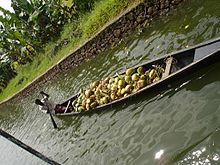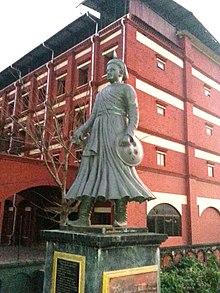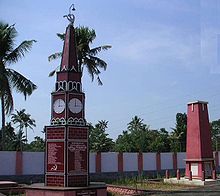A | B | C | D | E | F | G | H | CH | I | J | K | L | M | N | O | P | Q | R | S | T | U | V | W | X | Y | Z | 0 | 1 | 2 | 3 | 4 | 5 | 6 | 7 | 8 | 9
Alappuzha district
Alleppey district | |
|---|---|
|
Clockwise from top: Kettuvallam, Thottappally, Alappuzha Beach, Infopark Campus, Cherthala, Alappuzha Bypass, and Krishnapuram Palace at Kayamkulam. | |
| Nickname: | |
 Location in Kerala | |
| Coordinates: 9°29′N 76°29′E / 9.49°N 76.49°E | |
| Country | |
| State | Kerala |
| Headquarters | Alappuzha |
| Government | |
| • District Collector | John V Samuel, IAS[2] |
| Area | |
| • Total | 1,414 km2 (546 sq mi) |
| • Rank | 14th |
| Population (2011) | |
| • Total | 2,127,789 |
| • Density | 1,500/km2 (3,900/sq mi) |
| Languages | |
| • Official | Malayalam, English |
| Time zone | UTC+5:30 (IST) |
| ISO 3166 code | IN-KL |
| Vehicle registration | KL-04 Alappuzha, KL-29 Kayamkulam, KL-30 Chengannur, KL-31 Mavelikara, KL-32 Cherthala, KL-66 Kuttanad |
| HDI (2005) | |
| Website | alappuzha.nic.in |
Alappuzha district (Malayalam: [ɐːlɐpːuɻɐ] ⓘ), is one of the 14 districts in the Indian state of Kerala. It was formed as Alleppey district on 17 August 1957, the name of the district being changed to Alappuzha in 1990,[5] and is the smallest district of Kerala.[6] Alleppey town, the district headquarters, was renamed Alappuzha in 2012, even though the anglicised name is still commonly used to describe the town as well as the district.
A town with canals, backwaters, beaches, and lagoons, Alappuzha was described by George Curzon, the British Governor-General of India in the beginning of the 20th century CE, as the "Venice of the Eastern world."[1] The district is best known for its picturesque Kerala Backwaters, by which it is well connected to other parts of Kerala, including the tourist destination of Kumarakom, the district being a well known tourist destination in India. It is also known for its coir factories, as most of Kerala's coir industries are situated in and around the Alappuzha town.
The Vembanad lake, which lies below the sea level, is the longest lake in the Indian peninsula, and the district of Alappuzha lies between this lake and the Arabian Sea.[7] Kuttanad region of the Alappuzha district, which lies below the sea level, is the point of least elevation in the entire India.[7] Kuttanad, also known as The Rice Bowl of Kerala, has the lowest altitude in India, and is also one of the few places in the world where cultivation takes place below the sea level.[8][9]
The district was home to the Communist-led Punnapra-Vayalar uprising against the Divan of the British Princely state of Travancore in the 1940s.[10]
Etymology

Carved out of the erstwhile Kottayam and Kollam districts, Alappuzha district was formed on 17 August 1957 and consisted initially of seven taluks, namely Cherthala, Ambalappuzha, Kuttanad, Chengannur, Karthikappally and Mavelikkara.[11]
The name Ᾱlappuzha is a toponym. ‘Ᾱlayam’ means ‘home’ and ‘puzha’, according to Dr. Herman Gundert's dictionary, means ‘watercourse’ or ‘river’. The name refers to the network of waterways and backwaters in Alappuzha and its surrounding areas. The district is bounded on the north by Kochi and Kanayannur taluks of Ernakulam district, on the east by Vaikom, Kottayam and Changanassery taluks of Kottayam district and Thiruvalla, Kozhencherry and Adoor taluks of Pathanamthitta district, on the South by Kunnathur and Karunagappally taluks of Kollam district and on the west by Laccadive Sea.[12]
The present Alappuzha district comprises six taluks, namely Cherthala, Ambalappuzha, Kuttanad, Karthikappally, Chengannur and Mavelikkara.[13] The area of the district is 1,414 km2 (546 sq mi). Its headquarters is located at Alappuzha.
History

The present-day town of Alappuzha owes its existence to Raja Kesavadas during the second half of the 18th century CE. However the district of Alappuzha had an important position in the classical Malayalam literature. Kuttanad, the rice bowl of Kerala, was well known from the early Sangam period itself.
Classical antiquity

History records that the region which now constitutes the modern-day district of Alappuzha had trade relations with the ancient Greece, the ancient Rome, the ancient Levant, the ancient Arabian peninsula, and the Ancient Egypt during the Sangam period in the early centuries of the Common Era.[14]
The ancient port town of Barace which is recorded as an important centre of the Indian Ocean trade in the ancient Greco-Roman travelogues such as the Periplus of the Erythraean Sea (written around 50 CE) is often identified with the modern-day coastal town of Purakkad on the mouth of the Pamba River in the Alappuzha district.[15] This river is also the third-longest river in Kerala only after to the Periyar river and the Bharathappuzha river.[7]
Early members of the Chera dynasty had their home in Kuttanad and were sometimes known as the Kuttuvans.[15] However the regions south of the Pamba River was ruled by the Ay kingdom during the ancient period.[15] Pamba is mentioned as Baris in the ancient Greco-Roman travelogues.[15] There are archaeological evidences of the early period of this district, including ancient fossils, stone inscriptions and monuments, in the archeological sites like the excavation sites, the caves, the temples, etc.[15] The literary works of the Sangam period also help to take a look into the ancient period of the district.[15]
Alappuzha district was once a prominent centre of Buddhism in South India prior to the arrival of Nambudiri Brahmins into the region.[15] Sri Mulavasam was then a prominent Buddhist pilgrimage centre in the Indian peninsula.[15] Numerous remnants of once flourished Buddhism have been found from the taluks of Ambalappuzha and Mavelikara.[15]
Medieval history
The regions included in the district had a prominent position in the medieval Malayalam literary works such as Unnuneeli Sandesam.[15] One among the famous literary works of this period was the Ascharya Choodamani, a Sanskrit drama written by Sakthibhadra who was a scholar from Chengannur.[16]
The feudal monarch of Chempakasseri was at its zenith during the reign of Pooradam Thirunal Devanarayanan, a great scholar and a poet who was also the author of the literary work Vedantha Ratnamala. It is said that Ambalappuzha Sri Krishna Temple, at Ambalappuzha, was constructed and the idol of Lord Krishna installed during that time. Chempakassery was ruled by Brahmin monarchs during the medieval period.[15]
It is believed that Melpathur Narayana Bhattathiri, Kumaran Namboothiri, and Neelakanta Deekshithar were eminent scholars who patronized his court.[14]
Feudal principalities during the medieval period
The southern regions of the modern-day Alappuzha district once formed part of the erstwhile "kingdom of Odanad" (also known as the "kingdom of Kayamkulam" or known by the name "Onattukara"), which was later invaded by the Travancorean forces in the year 1746.[15] It was a branch of the ancient Ay kingdom.[15] It was also known as the Chirava Swaroopam, where the word Chirava derives from the combination of two Malayalam words, Cheru and Aayi, which means "a smaller branch of the Ay kingdom".[15] It included some parts of the modern-day Taluks of Chengannur, Mavelikara, Karthikappally, and Karunagappally.[15]
The northernmost region of the district, which curresponds to the present-day Taluk of Cherthala, was ruled by the "Kingdom of Karappuram" prior to the 1762 treaty that was signed between the kingdom of Travancore and the Kingdom of Cochin.[15] Karappuram was a tributary of the Kingdom of Cochin until 1762 when it was handed over to the kingdom of Travancore.[15] The headquarters of the "Madathingal branch" of the Cochin Royal family was situated at Madathinkara in Karappuram.[15]
South of Karappuram lied the "Chempakassery kingdom" which was also known by the name the "Kingdom of Purakkad" prior to the Travancorean conquest of 1746.[15] The kingdom of Chempakassery included the modern-day Taluks of Ambalappuzha and Kuttanad.[15] The monarch of Chempakassery was known by the title "Chempakassery Deva Narayanan".[15] Melpathur Narayana Bhattathiri and Kunchan Nambiar, who originally hailed from the South Malabar region, were court poets of the Chempakassery kingdom at times.[15]
Karthikappally was a small feudal kingdom that lied between the feudal kingdoms of Odanad and Chempakassery until the Travancorean invasion of the mid-18th century CE, which curresponds to the modern-day Taluk of Karthikappally.[15] The southernmost portion of the district had been once part of the erstwhile feudal kingdom of Karunagappally, which had been subordinate to the Chirava Swaroopam (Kayamkulam) at times.[15]
Progress and Social Reformation during the Travancore era (1746–1947)

In the 17th century the Portuguese power declined on the Malabar Coast and the Dutch Malabar gained a predominant position in the principalities of this district.[5] The church located at Kokkamangalam or Kokkothamangalam is believed to be one of the seven churches founded by St. Thomas the Apostle, one of the twelve disciples of Jesus Christ according to the oral traditions. The picturesque CSI Christ Church in Alappuzha town was built in 1816 by the first CMS (Church Missionary Society) missionary to India, Rev. Thomas Norton. It was the first Anglican Church to be established in the erstwhile state of Travancore.
It was during the mid-18th century CE that the Maharaja Marthanda Varma, popularly known as the ‘Architect of the Modern Travancore’, interfered in the political affairs of the smaller feudal principalities who ruled parts of the district. Marthandavarma Maharaja had a remarkable role in the internal progress of the district. The Krishnapuram Palace, which is now a protected monument of the State Archaeology Department, was constructed during his administrative period. He was known as the "Architect of the Modern Alleppey" and played a key role in making Alappuzha a premier port town of Travancore.[5]
During the reign of Balaramavarma Maharaja, Velu Thampi Dalava took keen interest in the development of the town and the port. He brought whole area of the Pathiramanal island into coconut cultivation and it's larger tracts into paddy cultivation. The role of Velu Thampi Dalava in the development of Alappuzha is worth mentioning. In the 19th century the district attained progress in all spheres.[5]
Kayamkulam Kochunni was a heroic outlaw from Kayamkulam who lived during the 19th century CE.[17] The 19th century social reformer Arattupuzha Velayudha Panicker hails from the modern-day district of Alappuzha.[18]
The first modern factory for the manufacture of Coir mats and mattings was also established in 1859 at Alappuzha. The Alappuzha Town Improvement Committee was set up in 1894.[5] During the Travancorean administration, Cherthala taluk was included in the Northern division (Kottayam division) while rest of the Taluks which together constitute the modern-day district of Alappuzha was placed under the Central division (Kollam division) of the British Princely state of Travancore.[19]

This district played a prominent role in the freedom struggle of Travancore. The campaign for the eradication of Untouchability was organized much earlier in this district by T.K. Madhavan, a journalist and in 1925 the approach roads to the temples, especially to the Ambalappuzha Sree Krishna Swamy Temple, were thrown open to the Hindus of all castes. The district also witnessed the ‘Nivarthana’ movement which was started as a protest against the constitutional repression in 1932. The first political strike in Kerala was held at Alappuzha in 1938.[5] The district was home to the Communist-led Punnapra-Vayalar uprising against the Divan of the British Princely state of Travancore in the 1940s.[10]
Geography

Alappuzha is on a peninsular landmass between the Arabian Sea and the Vembanad lake. Major rivers are the Manimala, the Pamba, and the Achankovil; their branches and tributaries flow through Alappuzha and empty into the Vembanad lake. The most important lake is Vembanad.[20]
Forest and wildlife

Alappuzha was the only district in Kerala without public forest land. But that changed in 2013, when 14.5 acres (5.9 ha) of land at Veeyapuram was declared as reserved forest by the Forest and Wildlife Department.[21]
Pathiramanal island on the Vembanad lake of Alappuzha district is famous for rare migrating birds.[22]
Administration


Alappuzha city is the administrative headquarters of the Alappuzha district. The district is divided into two revenue divisions-Alappuzha and Chengannur.[6]
Municipal towns
There are 6 municipal towns in the district. They are:[23]
Legislative representation
There are two Lok Sabha constituencies in Alappuzha: Alappuzha and Mavelikara.
There are nine Kerala Legislative Assembly seats in Alappuzha district.[24]
| Sl no. | Constituency | Member | Party | Alliance |
|---|---|---|---|---|
| 1 | Aroor | Daleema | CPI(M) | LDF |
| 2 | Cherthala | P. Prasad | CPI | LDF |
| 3 | Alappuzha | P. P. Chitharanjan | CPI(M) | LDF |
| 4 | Ambalappuzha | H. Salam | CPI(M) | LDF |
| 5 | Kuttanad | Thomas K. Thomas | NCP | LDF |
| 6 | Haripad | Ramesh Chennithala | INC | UDF |
| 7 | Kayamkulam | U Prathiba | CPI(M) | LDF |
| 8 | Mavelikara | M. S. Arun Kumar | CPI(M) | LDF |
| 9 | Chengannur | Saji Cherian | CPI(M) | LDF |
Taluks
The district is divided into two revenue divisions which together incorporate six Taluks within them.[25]
- Taluks in the Alappuzha Revenue Division are:[25]
| Cherthala | Ambalappuzha | Kuttanad[25] |
- Taluks in the Chengannur Revenue Division are:[25]
| Karthikappally | Mavelikkara | Chengannur[25] |
Revenue villages
Alappuzha district is divided into 93 revenue villages for the ease and decentralisation of its revenue administration.[25] They are further incorporated into 6 taluks as eludicated below.[25]
Cherthala Taluk
- Arookutty[25]
- Aroor[25]
- Arthunkal[25]
- Cherthala North[25]
- Cherthala South[25]
- Ezhupunna[25]
- Kadakkarappally[25]
- Kanjikuzhy[25]
- Kodamthuruth[25]
- Kokkothamangalam[25]
- Kuthiyathode[25]
- Mararikulam North[25]
- Pallippuram[25]
- Panavally[25]
- Pattanakkad[25]
- Perumbalam[25]
- Thanneermukkom North[25]
- Thanneermukkom South[25]
- Thuravoor South[25]
- Thaikkattussery[25]
- Vayalar East[25]
Ambalappuzha Taluk
Kuttanad Taluk
Karthikappally Taluk
Mavelikara Taluk
Chengannur Taluk
List of district collectors
List of Collectors of Alappuzha District according to length of tenure in descending order. The longest serving District Collector of Alappuzha was K. Balakrishna Kurup and the shortest serving District Collector was Sriram Venkitaraman.
K. Balakrishna Kurup served for 1146 days from 2 June 1980 to 23 July 1983, but from July 26, 2022, to August 2, 2022, Sriram Venkitaraman served for only 7 days from 26 July 2022 to 2 August 2022.[26]
| # | Collector | Number of days |
|---|---|---|
| 1 | Sriram Venkitaraman | 7 |
| 2 | P. Venugopal | 20 |
| 3 | P. M. Abraham | 38 |
| 4 | V. Retheesan | 42 |
| 5 | V. K. Vasudevan | 73 |








